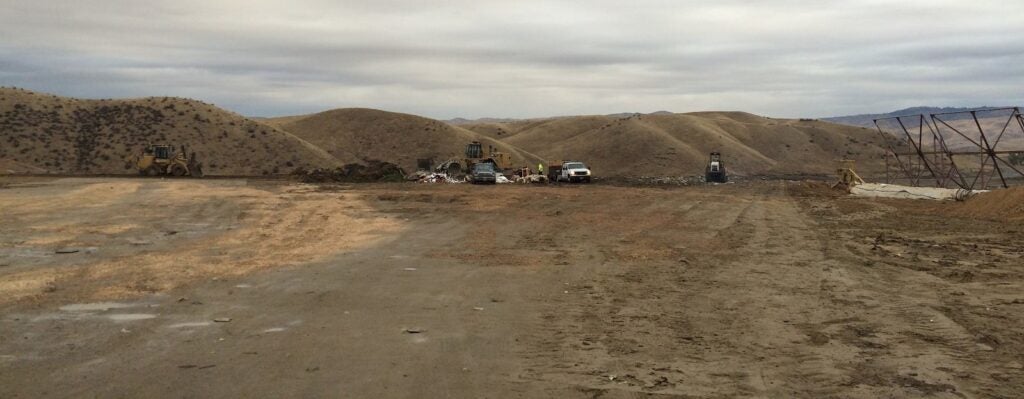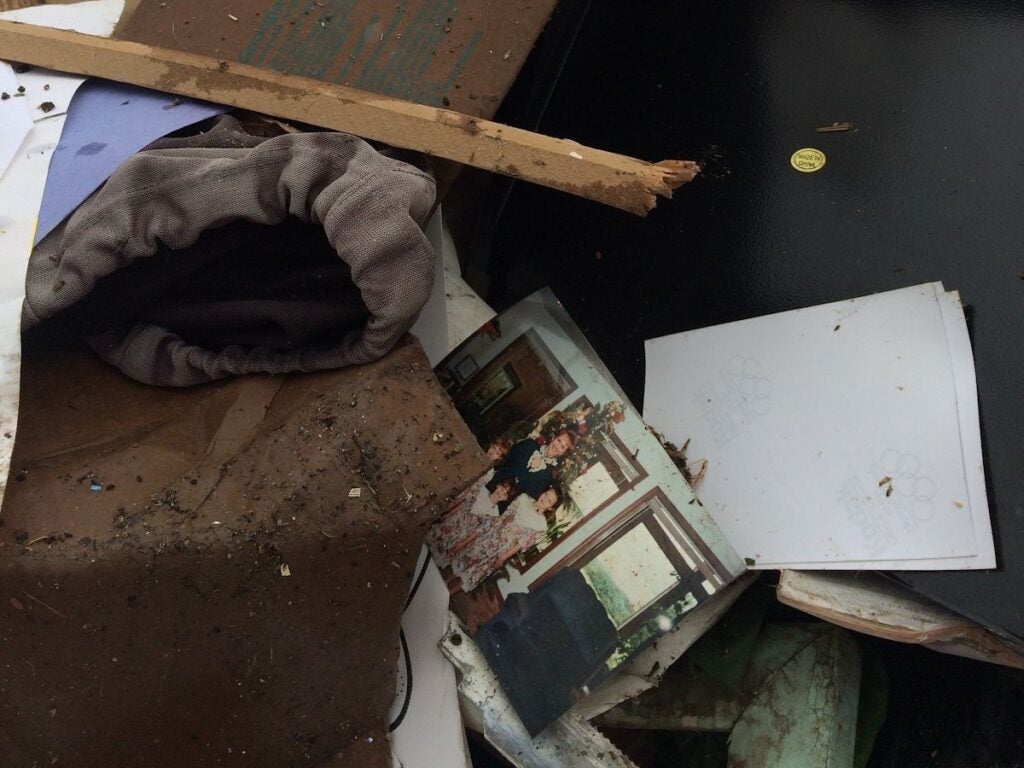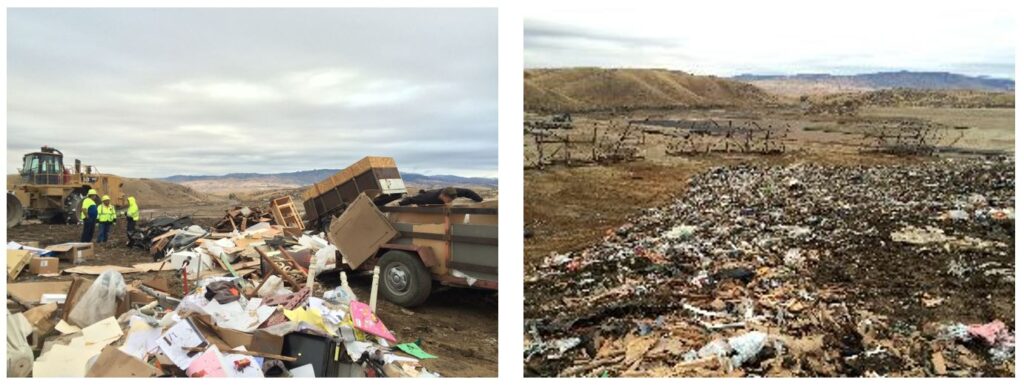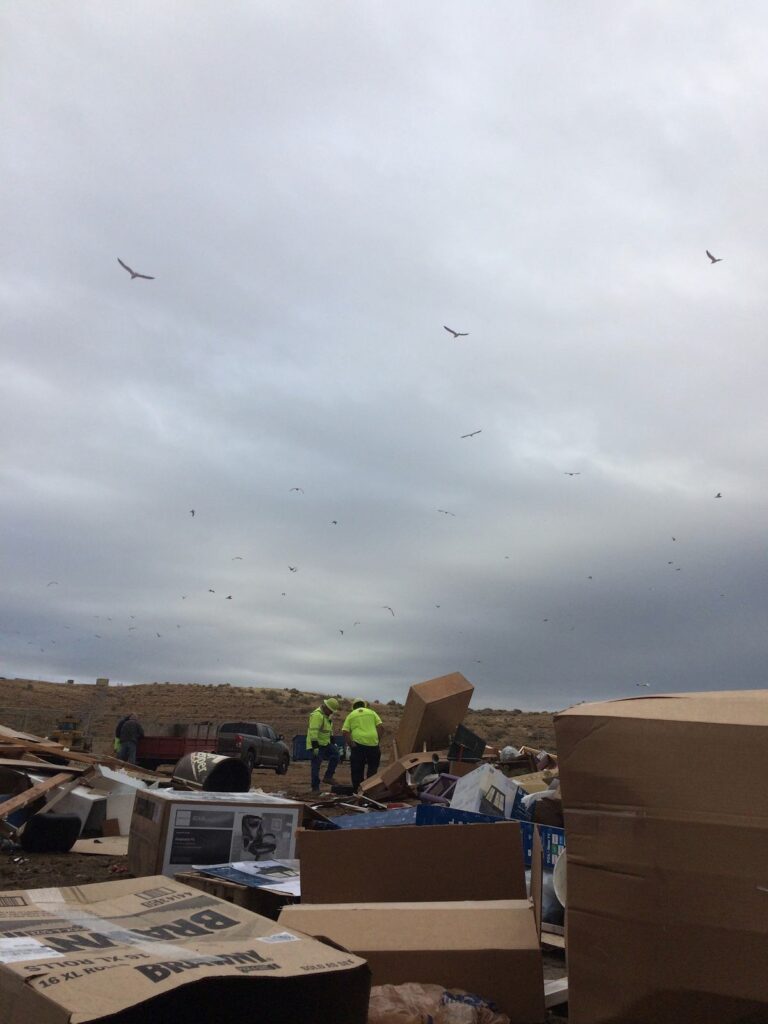Submissions for the Creative Non-Fiction category are open to one work of creative nonfiction completed for coursework in the last calendar year. Submissions should not exceed 20 pages. Kathleen Williams wrote the 3rd place, honorable mention submission in the Creative Nonfiction Category for the 2019 President’s Writing Awards.
Winning Manuscript – Landfill

Landfill Rd is like any other road winding deeper into the foothills. The sign signifying the Ada County Landfill’s entrance is in the shape of a rugged boulder. The emanating smell is fruity and metallic. Ada County Landfill charges patrons by the weight of the garbage deposited at the site, and measures this by weighing vehicles as they enter the site, giving them a ticket with that weight, and then weighing the vehicle again as it exits. Next to the scalehouse window, my car idled on the rectangular scale, and I told the scalehouse attendant that I was there to look around, not to dump anything. She gave me a birdwatching ticket and added “Although, there aren’t many birds around here,” as she waved me through.
There were birds, circling the brown land in a dense swirl as I continued down Landfill Rd. The road curls through a gradual incline and becomes unpaved. It felt like driving to a secluded hiking spot, following the arrows on the GENERAL PUBLIC signposts, until the road arrived at what seemed to be a flat precipice dropping off at the top of a foothill. Two lawn care trucks had their trailers backed up to an angular mound of debris, and their drivers were busy emptying the trailers of wood scraps and bulging trash bags. They threw their trash on the growing pile with the gusto of enjoyment. It smelled like what you’d expect trash to smell like, but not as strongly unpleasant as you might expect at a landfill.
Three men in neon workwear and hardhats, one in short sleeves despite the drizzle, stood in front of the compactor tractor taking a break. The cliff-like structure we stood on seemed too small to contain all solid waste not just from Boise, but from Nampa, Caldwell, and Meridian as well. The surface was smooth and so hard-packed that the drizzle wasn’t really turning the dirt into mud. Just a small flat plateau in the rounded foothills. I told the men in neon that I was surprised at the small size of the trash pile and they chuckled. That’s when I realized– this mound isn’t a pre-existing cliff being topped with trash. It is one element of an ongoing, segmented elevation process. The slightly muddy ground where we stood was merely the topmost layer of the landfill.
One man eyed my thin-soled Reeboks as I walked through the dirt to where the cliff ends, and advised me to watch where I stepped.
“There’s needles. Big, veterinarian needles.” Time reports that trash and recycling collectors have the fifth most dangerous job in the U.S., with 34.1 fatal injuries per 100,000 workers, caused by both the machines used to collect the trash, and objects that workers consistently come in contact with on the job.
Standing at the top of the spot currently being filled makes brings to mind Ada County Landfill’s slogan: “Environmentally Essential.” Maybe it’s because we’re in Idaho– this place, despite the mass of trash, feels so weirdly nature-like. The trash that arrived that morning had not yet been compacted, and it sloped down the side of the land like sand on a shore. Older landfill pieces have become disguised with the growth of new grass and sagebrush, turning the surface back into a uniform part of the landscape. I hiked through the trash ripely dropped off that morning and the smell’s intensity increased the further I got from the cleanly-compacted level of the previous day, through the crooked, familiar shapes of everything discarded. I stood on the tampons and condoms and lugies of my friends and enemies. All the shards of glass I’ve accidentally broken in the three years I’ve lived in Boise are here! Paper towels used to soak the moldy growth behind the sink of the dorm I lived in three years ago. And of course all the things that I’ll never remember, thanks to that comforting belief that once I close the lid on the swollen trash bag, everything inside no longer exists.

The man in short sleeves waved his hand across the landscape like someone might to say “the world is your oyster.” Delicate shadows filtered through the overcast sky and highlighted the intricate textures of the surfaces of hills.
“This…” he said. “Underneath all this, is garbage.”
The office building sits right at the landfill entrance, at the foot of the road winding upward. People who work here dress in business casual and the floor reverberates with the clumping steps of heavy boots. When I arrived to speak to Theresa Rademacher, the Business Analyst at Ada County Landfill, she was out on the grounds, giving a tour of the place to a group of first graders. Rademacher has a degree in writing and a degree in literature. “Everything you read on our website, I wrote,” she says with a smile. An instrument in her office emits a steady buzz for the entire eighteen minutes I am there, which feels comforting and scientific. Her eyes, lined in a dark green that matches her shirt, are unwavering as she explains the structure of Ada County’s municipal waste management system.
The landfill currently in use is called the North Ravine Cell. Rademacher refers to its filling as an ongoing process, and says that when “complete” (completely full), it is planned to measure 300 acres. The “segment” that’s being filled right now, which is the plateau-like area where I stood, is 30 square acres and will be raised to 100 feet. After it reaches that height, they will move horizontally and fill the next segment, “Phase 2,” which will be the same dimensions.
North Ravine complies with the Environmental Protection Agency’s regulations for a “Subtitle D” landfill. One of the provisions which came into effect in 1992 required the newly-compacted waste to be covered every day, to control vectors (organisms that transmit disease), scavengers, odor, and other ways that waste could be carried out of the landfill. Aside from covering each layer with dirt, a large beige tarp is stretched across the surface every night.

Following Subtitle D landfill instructions, to prepare a new section of the landfill they first dig a small amount to level the land, and then stretch a high-density polyethylene plastic sheeting, called a liner, across the bottom. Phase 2 is being prepared right now. The liner looks like a huge black trash bag stretched over a football field.
I asked the men working up at the landfill what they think about the “100 year” plan of North Ravine. They shook their heads, seeming to suggest that they don’t think it will last that long. “Ask him,” they said, pointing to the man with the mustache who was bashfully hanging back, “he’s worked here for ten years.” When I asked him how much has changed since he began working here a decade ago, everyone laughed even harder. His eyebrows slowly rose and he rubbed his gloved hands together, turning in a circle looking at all the irregularly-elevated land around him, all these mounds.
“Oh, man.” He finally said, “I just– I couldn’t even tell you.”
Half of what Rademacher tells me about Ada County Landfill is the standard report of reckless human destruction that I expected. With the current state of the recycling markets, things like non-corrugated cardboard (the thin stuff of cereal boxes) are no longer accepted, but many consumers still stick it in their bins. Recycling programs end up having to drive it here. There are 79 years of space left in the North Ravine property owned by the landfill, and places with conditions suitable to construct another impact-conscious landfill will be difficult to find. Rademacher stresses the word “finite” about the place, the dusty land we’re sitting on.
“We can’t keep doing what we’re doing, but what are the alternatives?” She asks, in a way that is not a moral or environmentalist argument, but more of an informed observation.
But remember their slogan, environmentally essential? Written on Ada County Landfill’s website, under the subtitle “What Happens to Your Trash,” is this promise: “No matter what type of waste is brought to the Landfill, we believe in utilizing the most environmentally efficient method of disposal, ensuring the longevity of the Ada County Landfill.” She says the best thing to focus on as a community is local recycling– for example, the wood recycling site they have on the property makes wood into chips which are purchased by a rancher in South Meridian and used first for cattle bedding and then for compost. This is Rademacher’s “perfect example” of local recycling.
“There’s a difference between a landfill and a dump,” She says, spitting out the word “dump” with disdain. Dishearteningly, many peers I spoke to about the landfill use the two words interchangeably, oblivious of the work in place to control the dangers of rotting waste. She unveiled many assumptions I didn’t even know I’d made about waste management, absorbed from the population’s disinterest about where the byproducts of their existence end up. Like the fact that Ada County Landfill is 100% privately funded. One thing that people don’t really understand, Rademacher says, is that “garbage is expensive, to do it right,” meaning to secure its final resting place in a way least harmful to the environment is expensive.
In 2013, Ada County Landfill closed Hidden Hollow Landfill, the landfill preceding North Ravine. Because it no longer accepts waste, they no longer profit from Hidden Hollow, but it is required that it be monitored for 30 years after closure, so they must allocate funds to this. No one thought to put a liner at the bottom of Hidden Hollow when it was initiated in 1972. As it turns out, it sits right on top of an aquifer.
Did the people who started Hidden Hollow know it was on top of an aquifer?
“Um, I don’t think anybody realized how dangerous garbage is,” Rademacher said. “It used to be, you just dug a hole and threw trash in and hoped it never came back.”
A primary aspect of both maintaining a landfill-in-progress and of monitoring a closed landfill is taking care of landfill gas, also called LFG. This is the gas which is the main cause of pollution to the aquifer below the Hidden Hollow landfill. As all the intensely compacted objects in the landfill become buried deeper and deeper, layer by smooth layer, oxygen is eventually eliminated from the trash’s decomposition process. LFG is the byproduct of this anaerobic decomposition, a gas that is 40% to 60% methane and 35% to 50% carbon dioxide, but is its own unique mixture of many other elements. On their informational page about Landfill Gas, the EPA states that municipal solid waste landfills are the “third-largest source of human-related methane emissions in the United States.” Gas that escapes the landfill out into open air is called “fugitive emission,” and can be smelly, dangerous (potentially combustible), and is a greenhouse gas. As part of the effort to reduce Hidden Hollow’s pollution to the aquifer, a “ground remediation” program has been implemented, in which the aquifer’s water is cleaned and reintegrated into the aquifer downstream from Hidden Hollow.
Not quite an alternative, but a method of reducing harm caused by LFG, is to extract it. The EPA also opines that escaped LFG emissions from landfills “represent a lost opportunity to capture and use a significant energy resource.” That opportunity was grasped by Ada County Landfill in 2007, when they became the first “biomass” gas-to-energy project in Idaho. Perforated pipes were vertically installed into the antique layers of Hidden Hollow, and a vacuum system is used to pump the gas out of the ground. There are two generators on site, owned by a private company, Foristar, which convert the LFG into energy.
“And then it goes onto the grid,” says Rademacher. Ada County Landfill receives royalties from Foristar after the energy has been sold to Idaho Power. She stresses the importance of cost-effectiveness when implementing innovations– in concluding their informational text about Landfill gas-to-energy, the EPA says that the landfill gas-to-energy process alone gives landfills the ability to reduce the costs associated with complying to EPA regulations, like costs of monitoring Hidden Hollow for 30 years, “by turning pollution into a valuable community resource.”
This whole “project,” as everyone calls it, seemed very community-based when I learned about it, to the point where I assumed a group of community members had come up with its design. So when I went to Idaho Power to learn more about the process I was expecting a story of representatives from the landfill, Idaho Power, and local government coming together. I imagined them sitting at a conference table, showing each other some optimistic charts and graphs, shaking each others’ hands.
Idaho Power’s office in downtown Boise is so different from the landfill’s office. Two security guards hunker in their squishy chairs behind a granite desk, and a flatscreen TV alternates between playing Idaho Power TV ads and displaying social media posts from satisfied customers: “Thanks so much Greg from Idaho Power for rescuing our kitty!” reads a tweet on the screen.
Michael Darrington is the Energy Contracts Leader, and manages energy purchase agreements from sources not owned by Idaho Power.
“So,” I asked him, excited to hear a story of community collaboration, “who introduced the idea of turning landfill gas into power?” He sat with excellent posture, surveying the blank wall behind me, evidently thinking about how to explain it to me.
“It wasn’t– so… our involvement with this project is thanks to a forty-year-old federal law.” His furrowed eyebrows disappeared behind his rectangle glasses. This law is PURPA, the Public Utility Regulatory Policies Act, was created in 1978 during what Darrington describes as “a push to solve what they called an ‘energy crisis.’” Under PURPA, renewable energy generation projects including solar and wind, as well as biomass, request a contract from Idaho Power, he says, on a “must-take, must-purchase” basis. Idaho Power owns their own resources for generating hydropower, but with PURPA contracts, they play no part in the development.
An independent power producer deals with all of the extraction and production, and “Idaho Power just has to buy it,” he says. Under this system there has been a steady progression of development of renewable energy generation facilities throughout the next decades. The Union of Concerned Scientists credits PURPA to be the “most effective single measure in promoting renewable energy,” but to Idaho Power, it is squelching. Darrington’s very short hair seems to stand on end when he speaks about PURPA.
“Historically, Idaho has always been a primarily renewable state,” he says, because of their primary use of hydropower in generating electricity, which they’ve put stock into since their beginnings in the 1916. They report that in 2017 hydro generated 49.5% of their electricity. After that was coal at 18% (also generated in facilities owned by Idaho Power) and wind at 10%. Aside from Hidden Hollow, Idaho Power has gas-to-energy contracts in North Idaho Landfill in Kootnai County, Bannock County Landfill in Pocatello, and Southern Idaho Solid Waste in Burley. Idaho Power reports that these biomass sites, which include these landfill gas sites as well as projects which convert the gas from dairy waste into energy and projects which burn timber or other agricultural material, made up .78% of their energy in 2017.
“Whether its of value to increase renewable sources is up for debate,” Darrington told me, and I’m not sure if he meant monetary or environmental value. He kept referring to the customers’ expectations– people paying for power expect a steady stream at all times, and they want prices to be reasonable. Once power from biomasses is purchased through PURPA, the price becomes a “power supply expense” and is passed on to the customers to pay.
His main point for me was that the balance needed to achieve customer’s demand requires a variety of sources. Because PURPA sources like solar and wind are always fluctuating, Idaho Power must use their pre-established, non PURPA sources of hydro, natural gas, and coal, to balance out the fluctuations and keep the flow steady, at the “fairest” price. These are the same customers who expect a steady stream of objects available to be purchased, and a steady stream of heaving, sighing blue trucks to “eliminate” the waste from their lives.
The second time I visited the landfill, I took the public bus as far as I could and then biked the last mile. As I stepped off the bus I placed the disposable coffee cup I’d finished into the small trash can by the accordion doors. Blocky blue trash trucks barreled uphill past me on the road to the landfill and I smelled that metallic fruity smell in their small bursts. The landfill has purchased land all around itself, a “buffer zone” of strategic isolation. It keeps progressing land development from encroaching on the waste site, and lessens the risk of animals and wind carrying unpleasant items (and disease) from the trash out into populated areas. Like lots of land in Idaho, some of the buffer land is open for public use, including ten miles of bike trails and two miles of foot trails. From the top of an incline one can look past the lumps of brown and clusters of dark green, spiny bushes, and see pieces of Boise spread below like legos.
My friend Amber grew up here and immediately knew what I meant when I asked about trails around the landfill. She took me there one Sunday morning and we ran our hands over the tops of the tall brown grass as we walked, and pressed into the scraggly sagebrush to make room on the narrow path for bikers to pass. We thought we might be able to see the landfill below us but only came across a quarry-like scene. Yellow shoveling machines parked with their shovels up, in a white dusty hole. We stood there and looked down at it.
Later I looked at the map of the entire landfill site plan, and it seems that what we were looking at is called the Soil Borrow Area. The complete outline of the landfill site is is not a perfect circle framing the landfill, but rather the areas of strategically-acquired buffer zone make the border of the site look sort of like a puffy outline of Texas. A whiff of trash caught up to us only once. The parking lot of the trail is adjacent to a cemetery, up the hill a little more. She was showing me the trails, so she might as well show me the cemetery too, she said, and drove through the open gates and down the small asphalt path with her eyes looking straight ahead. Her little brother died when he was four years old and is buried here.
“My mom never visits the grave though,” Amber told me as we drove, not stopping the car and eventually turning back on the road to Boise. “She doesn’t think it’s the right way to ‘visit’ him. Like, that’s not him somehow still there underground. It’s just a body.”
The rolls of tall dry grass and twirling sagebrush is replaced with a gentle manicured green.
Shortly after speaking to Rademacher I was at a family reunion and went to an arcade with the kids. They loved a machine which guaranteed catching a rubber ducky with a claw hand. Each plastic toy dropped out of the machine in a thin plastic bag, which the kids ripped open and deposited in the corner trash can in a deft, sugar rushed blur. The movement is as thoughtless and life-necessary as filling a glass of water at the sink. At this point I was still sort of shivering every time I threw something away. No one’s gonna dig this out and find a way to prevent it from being part of that broken angular mass, spread across the layer below, covered in dirt…etc. But still I accepted the spork in the plastic sheath. I habitually swirled the ice of my drink around with the shiny cocktail straw. I asked the kids if they knew where their trash goes, and when they shook their heads, I told them, feeling self-indulgent.
“It gets buried. When they’re all done burying it, it looks like a normal hill, because they cover it with dirt and grass on top. But the trash underneath… stays there for-ev-er.” The blonde little boy grinned at me like he was too old to be lied to, like I was insisting the existence of Santa Clause.
“I don’t believe you,” he said. The others nodded behind him. I sat down to be at eye level with them and scrolled through the photos I’d taken on my phone. Their smiles twitched. I immediately felt guilty, put my phone away, and changed the subject. Telling the kids about landfills felt reckless, like I was robbing them of the comforting, untainted glow of responsible caretaker that they see around adults. Why does it feel this way?
Rademacher doesn’t yet have plans for Hidden Hollow after the thirty years of monitoring end. Closed landfills are unsafe to build on; the amount that the trash in Hidden Hollow “settled” was so extreme, that after letting it sit and settle for eighteen months, enough space was left to continue disposing trash for two additional years before it reached its full engineering capacity. She’s heard of parks being built on closed landfills, as well as solar panel farms. In Boise, the unpaved parking lot of Simplot Field is on top of the landfill that preceded Hidden Hollow.
Up on North Ravine Cell, the man in neon short sleeves spoke to me with the most ease, like he’d either been holding his opinions in for a long time, waiting for someone to listen, or like he tells people this all the time and is well-rehearsed in his facts. “Eighty percent of this stuff should be recycled,” he told me (a Boise Weekly article from 2014 more accurately estimates 25% to 40%).

“You should see some of the stuff people drop here,” he said, “Antiques… cardboard…” He directed my attention to an ornate wooden chair splayed face-down in the pile. It looked like its leg had been broken when the man getting rid of it had thrown it out of his truck bed so emphatically. Once the objects of “trash” cross the scalehouse’s scale, any potential further future they might have had above ground is eradicated. When it crosses that scale, it belongs to Ada county, he shrugged– “and we gotta bury it.”
I told him I’m also surprised by how mild the smell is. “I drive that contraption–” he pointed to the compactor tractor, with spikes as big as pint milk jugs coating its metal wheels. Inside the enclosed cockpit the air is filtered. He said that when he’s up there, in his tractor, he doesn’t smell a thing.